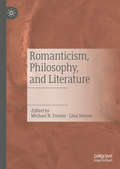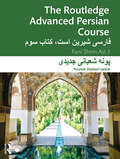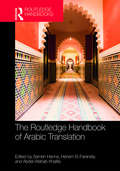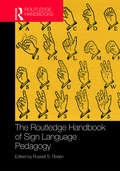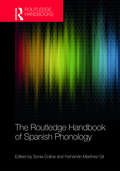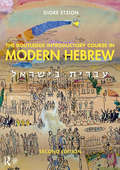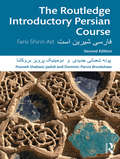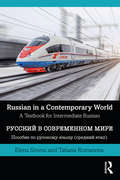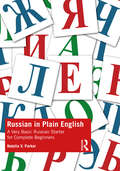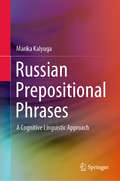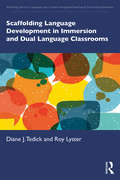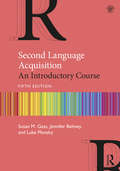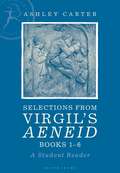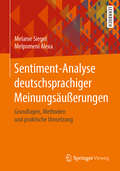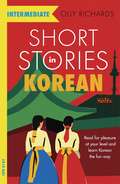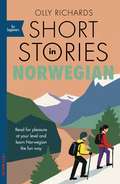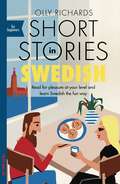- Table View
- List View
Romanticism, Philosophy, and Literature
by Michael N. Forster Lina SteinerThis book offers a broad re-evaluation of the key ideas developed by the German Romantics concerning philosophy and literature. It focuses not only on their own work, but also on that of their fellow travelers (such as Hölderlin) and their contemporary opponents (such as Hegel), as well as on various reactions to and transpositions of their ideas in later authors, including Coleridge, Byron, Kierkegaard, Nietzsche, and Dostoevsky.
The Routledge Advanced Persian Course: Farsi Shirin Ast 3
by Pouneh Shabani-JadidiThe Routledge Advanced Persian Course: Farsi Shirin Ast 3 aims to help students of higher-level proficiency continue elevating their proficiency level to achieve near-native level. Key features include: Authentic texts on a variety of topics related to Iran’s history, geography, arts, literature, culture, religions, society, and people. Each lesson includes a prominent poet and their most representative poem familiarizing students with the Persian literary canon, while indirectly learning the higher order registers used in the language of poetry. Lessons end with a Persian proverb and the story behind it, so that students will not only master the language but also the culture of the language and reach a near-native level of linguistic and cultural proficiency. The proverbs and some of the classical poetry are written in the calligraphy form to make students get used to reading handwritten texts resembling calligraphy. Audio files are provided so that learners who are studying on their own can have access to correct pronunciations. This textbook continues the series from The Routledge Intermediate Course in Persian and is ideal for Advanced or B2-C1 level students of Persian.
The Routledge Advanced Persian Course: Farsi Shirin Ast 3
by Pouneh Shabani-JadidiThe Routledge Advanced Persian Course: Farsi Shirin Ast 3 aims to help students of higher-level proficiency continue elevating their proficiency level to achieve near-native level. Key features include: Authentic texts on a variety of topics related to Iran’s history, geography, arts, literature, culture, religions, society, and people. Each lesson includes a prominent poet and their most representative poem familiarizing students with the Persian literary canon, while indirectly learning the higher order registers used in the language of poetry. Lessons end with a Persian proverb and the story behind it, so that students will not only master the language but also the culture of the language and reach a near-native level of linguistic and cultural proficiency. The proverbs and some of the classical poetry are written in the calligraphy form to make students get used to reading handwritten texts resembling calligraphy. Audio files are provided so that learners who are studying on their own can have access to correct pronunciations. This textbook continues the series from The Routledge Intermediate Course in Persian and is ideal for Advanced or B2-C1 level students of Persian.
The Routledge Handbook of Arabic Translation
Translation-related activities from and into Arabic have significantly increased in the last few years, in both scope and scale. The launch of a number of national translation projects, policies and awards in a number of Arab countries, together with the increasing translation from Arabic in a wide range of subject areas outside the Arab World – especially in the aftermath of the Arab Spring – have complicated and diversified the dynamics of the translation industry involving Arabic. The Routledge Handbook of Arabic Translation seeks to explicate Arabic translation practice, pedagogy and scholarship, with the aim of producing a state-of-the-art reference book that maps out these areas and meets the pedagogical and research needs of advanced undergraduate and postgraduate students, as well as active researchers.
The Routledge Handbook of Arabic Translation
Translation-related activities from and into Arabic have significantly increased in the last few years, in both scope and scale. The launch of a number of national translation projects, policies and awards in a number of Arab countries, together with the increasing translation from Arabic in a wide range of subject areas outside the Arab World – especially in the aftermath of the Arab Spring – have complicated and diversified the dynamics of the translation industry involving Arabic. The Routledge Handbook of Arabic Translation seeks to explicate Arabic translation practice, pedagogy and scholarship, with the aim of producing a state-of-the-art reference book that maps out these areas and meets the pedagogical and research needs of advanced undergraduate and postgraduate students, as well as active researchers.
The Routledge Handbook of Sign Language Pedagogy (Routledge Language Handbooks)
by Russell S. RosenThe Routledge Handbook of Sign Language Pedagogy is the first reference of its kind, presenting contributions from leading experts in the field of sign language pedagogy. The Handbook fills a significant gap in the growing field of sign language pedagogy, compiling all essential aspects of current trends and empirical research in teaching, curricular design, and assessment in one volume. Each chapter includes historical perspectives, core issues, research approaches, key findings, pedagogical implications, future research direction, and additional references. The Routledge Handbook of Sign Language Pedagogy is an essential reference for sign language teachers, practitioners, and researchers in applied sign linguistics and first, second, and additional language learning.
The Routledge Handbook of Sign Language Pedagogy (Routledge Language Handbooks)
by Russell S. RosenThe Routledge Handbook of Sign Language Pedagogy is the first reference of its kind, presenting contributions from leading experts in the field of sign language pedagogy. The Handbook fills a significant gap in the growing field of sign language pedagogy, compiling all essential aspects of current trends and empirical research in teaching, curricular design, and assessment in one volume. Each chapter includes historical perspectives, core issues, research approaches, key findings, pedagogical implications, future research direction, and additional references. The Routledge Handbook of Sign Language Pedagogy is an essential reference for sign language teachers, practitioners, and researchers in applied sign linguistics and first, second, and additional language learning.
The Routledge Handbook of Spanish Phonology (Routledge Spanish Language Handbooks)
by Sonia Colina Fernando Martínez-GilThe Routledge Handbook of Spanish Phonology brings together leading experts in Spanish phonology to provide a state-of-the-art survey of the field. The five sections present current research on the phonological structure of Spanish including the most prominent segmental processes, suprasegmental features, the ways Spanish phonology interacts with other modules of grammar, the acquisition of Spanish phonology by first and second language learners, and an analysis of phonological variation and sound change. This volume provides comprehensive and detailed coverage of Spanish phonology. It addresses major burning questions and pressing issues that have arisen in the study of Spanish phonology, and is an essential reading resource for graduate students and researchers in the field.
The Routledge Handbook of Spanish Phonology (Routledge Spanish Language Handbooks)
by Sonia Colina Fernando Martínez-GilThe Routledge Handbook of Spanish Phonology brings together leading experts in Spanish phonology to provide a state-of-the-art survey of the field. The five sections present current research on the phonological structure of Spanish including the most prominent segmental processes, suprasegmental features, the ways Spanish phonology interacts with other modules of grammar, the acquisition of Spanish phonology by first and second language learners, and an analysis of phonological variation and sound change. This volume provides comprehensive and detailed coverage of Spanish phonology. It addresses major burning questions and pressing issues that have arisen in the study of Spanish phonology, and is an essential reading resource for graduate students and researchers in the field.
The Routledge Introductory Course in Modern Hebrew: Hebrew in Israel
by Giore EtzionThe Routledge Introductory Course in Modern Hebrew is an integrated language course designed ideally for classroom–based learners. Adopting an eclectic approach, the course contains 90 lessons combining authentic texts, grammar explanations, and exercises with audiovisual materials to guide and support the student through the key skills of reading, writing, speaking and listening. Features include: A wide range of texts, from dialogues and simple narratives to newspaper articles and poetry Over 30 additional passages for extended reading Vocabulary lists for each text A variety of exercises for every lesson including oral drills, listening comprehension, grammarexercises and writing practice Glossaries for each unit and a comprehensive dictionary Thorough explanation of all the grammatical issues that arise at the introductory level A solid grammatical foundation presented in an accessible, user-friendly manner Cultural notes to introduce students to Israeli society All the texts, wordlists, and verb conjugations are freely available in an audiovisual format on the companion website:http://routledgehebrew.com/ An integral part of the course, the website also contains a wealth of additional resources including: Answers to all of the exercises in the book Interactive exercises Audiovisual verb dictionary Audiovisual charts of prepositions and nouns with their pronoun suffixes Audiovisual reference charts of numbers, colors, the days of the week, etc. Checklists and review lessons for each unit Links to Israeli websites Videos and music The Routledge Introductory Course in Modern Hebrew provides everything that students and instructors need for an engaging and effective learning environment.
The Routledge Introductory Persian Course: Farsi Shirin Ast
by Dominic Parviz Brookshaw Pouneh Shabani-JadidiThe Routledge Introductory Persian Course: Farsi Shirin Ast is an innovative course designed for students who are new to the language. Focusing on grammatical and communicative competence, the course contains 15 lessons combining dialogues and texts with grammar explanations, exercises and audio materials to guide and support the student through the key skills of reading, writing, speaking and listening. Key features include: Lively, content-based materials – the language is taught and practiced through a variety of dialogues and texts on the culture, history, and traditions of Iran Complete vocabulary lists – each vocabulary entry contains the English meaning, the part of the speech in Persian, as well as a sample sentence in Persian Colloquial situational dialogues – students are introduced to spoken Persian from the outset Carefully controlled exercises – new grammatical points are practiced in a variety of controlled exercises that bridge between students’ in existing information and the new information Audio material – students can develop natural pronunciation by imitating the audio recordings of the vocabulary, dialogues, and texts available freely online Glossaries – comprehensive Persian to English and English to Persian glossaries The course provides everything that students and instructors need for an engaging and effective learning environment. Revised and updated, this new edition includes more vocabulary and grammar activities, clearer learning outcomes and an updated comprehensive companion website.
The Routledge Introductory Persian Course: Farsi Shirin Ast
by Dominic Parviz Brookshaw Pouneh Shabani-JadidiThe Routledge Introductory Persian Course: Farsi Shirin Ast is an innovative course designed for students who are new to the language. Focusing on grammatical and communicative competence, the course contains 15 lessons combining dialogues and texts with grammar explanations, exercises and audio materials to guide and support the student through the key skills of reading, writing, speaking and listening. Key features include: Lively, content-based materials – the language is taught and practiced through a variety of dialogues and texts on the culture, history, and traditions of Iran Complete vocabulary lists – each vocabulary entry contains the English meaning, the part of the speech in Persian, as well as a sample sentence in Persian Colloquial situational dialogues – students are introduced to spoken Persian from the outset Carefully controlled exercises – new grammatical points are practiced in a variety of controlled exercises that bridge between students’ in existing information and the new information Audio material – students can develop natural pronunciation by imitating the audio recordings of the vocabulary, dialogues, and texts available freely online Glossaries – comprehensive Persian to English and English to Persian glossaries The course provides everything that students and instructors need for an engaging and effective learning environment. Revised and updated, this new edition includes more vocabulary and grammar activities, clearer learning outcomes and an updated comprehensive companion website.
Russian in a Contemporary World: A Textbook for Intermediate Russian
by Elena Simms Tatiana RomanovaRussian in a Contemporary World is an intermediate textbook with a focus on improving oral and written skills of the Russian language by encouraging students’ creative potential with their use of language in a contemporary society, such as media, TV, art, and technology. Key features of the textbook include: Use of original texts and application of material by choosing topics which reflect the students’ general interests, according to a survey conducted among Humanities undergraduates and which are essential for students of Russian language, culture, and society; Practical skills: the textbook allows students to process primary text sources, summarising, writing, and expressing their views on certain sociopolitical issues; Raises issues which are being widely discussed in present-day Russia and introduces trends in the development of modern Russian society; Providing feedback: students can check their work against answer keys that feature in a number of exercises as well as find discussions on different grammatical topics in the Appendix. Aimed at B1-B2 and Intermediate-Mid students of Russian, this is the ideal textbook for those aiming to improve their Russian whilst gaining knowledge of contemporary Russian culture and society. With answer keys and grammar topics included, the textbook is also ideal for independent study.
Russian in a Contemporary World: A Textbook for Intermediate Russian
by Elena Simms Tatiana RomanovaRussian in a Contemporary World is an intermediate textbook with a focus on improving oral and written skills of the Russian language by encouraging students’ creative potential with their use of language in a contemporary society, such as media, TV, art, and technology. Key features of the textbook include: Use of original texts and application of material by choosing topics which reflect the students’ general interests, according to a survey conducted among Humanities undergraduates and which are essential for students of Russian language, culture, and society; Practical skills: the textbook allows students to process primary text sources, summarising, writing, and expressing their views on certain sociopolitical issues; Raises issues which are being widely discussed in present-day Russia and introduces trends in the development of modern Russian society; Providing feedback: students can check their work against answer keys that feature in a number of exercises as well as find discussions on different grammatical topics in the Appendix. Aimed at B1-B2 and Intermediate-Mid students of Russian, this is the ideal textbook for those aiming to improve their Russian whilst gaining knowledge of contemporary Russian culture and society. With answer keys and grammar topics included, the textbook is also ideal for independent study.
Russian in Plain English: A Very Basic Russian Starter for Complete Beginners
by Natalia V. ParkerRussian in Plain English enables complete beginners to acquire the skill of reading words written in Cyrillic independently, with no English transcription or imitated pronunciation, within a short period of time. This book introduces the Cyrillic alphabet gradually, feeding in the letters and their various pronunciation aspects one by one over its ten units, thus building a complete picture of the Russian sound and writing systems. It also highlights the interrelationship of the two systems and helps learners to see the logic behind the use of the Cyrillic alphabet. In addition, the book teaches learners to produce Russian word stress on a marked syllable, contributing to stress acquisition. Furthermore, the book explains the basic grammatical features of Russian words and the rules of how to put them into sentences, enabling learners to start saying things in Russian from Unit 1. It employs some findings of research in language processing, helping learners to start building their speaking and reading skills. This book is an essential guide for all beginners, including students and independent learners.
Russian in Plain English: A Very Basic Russian Starter for Complete Beginners
by Natalia V. ParkerRussian in Plain English enables complete beginners to acquire the skill of reading words written in Cyrillic independently, with no English transcription or imitated pronunciation, within a short period of time. This book introduces the Cyrillic alphabet gradually, feeding in the letters and their various pronunciation aspects one by one over its ten units, thus building a complete picture of the Russian sound and writing systems. It also highlights the interrelationship of the two systems and helps learners to see the logic behind the use of the Cyrillic alphabet. In addition, the book teaches learners to produce Russian word stress on a marked syllable, contributing to stress acquisition. Furthermore, the book explains the basic grammatical features of Russian words and the rules of how to put them into sentences, enabling learners to start saying things in Russian from Unit 1. It employs some findings of research in language processing, helping learners to start building their speaking and reading skills. This book is an essential guide for all beginners, including students and independent learners.
Russian Prepositional Phrases: A Cognitive Linguistic Approach
by Marika KalyugaThe book presents a comprehensive study of Russian prepositions, with a focus on expressing spatial characteristics. It primarily deals with how metaphorical and metonymical transfers motivate the use of Russian prepositional phrases, explaining the collocations of prepositional phrases with verbs as a realisation of a conceptual metaphor or a metonymy. The author confronts a problem that is attracting growing attention within present-day linguistics: the semantics of prepositions and cases. The book seeks to clarify the conceptual motivations for the use of the combinations of Russian primary prepositional phrases, as well as to demonstrate how their spatial meanings are extended into non-spatial domains. This book incorporates an analysis of a large number of items, including 30 combinations of primary prepositions with cases. An original contribution, the book is of interest to teachers and students studying Slavic languages, and to cognitive linguists.
Scaffolding Language Development in Immersion and Dual Language Classrooms (Routledge Series in Language and Content Integrated Teaching & Plurilingual Education)
by Roy Lyster Diane J. TedickThis book introduces research-based pedagogical practices for supporting and enhancing language development and use in school-based immersion and dual language programs in which a second, foreign, heritage, or indigenous language is used as the medium of subject-matter instruction. Using counterbalanced instruction as the volume’s pedagogical framework, the authors map out the specific pedagogical skill set and knowledge base that teachers in immersion and dual language classrooms need so their students can engage with content taught through an additional language while continuing to improve their proficiency in that language. To illustrate key concepts and effective practices, the authors draw on classroom-based research and include teacher-created examples of classroom application. The following topics are covered in detail: defining characteristics of immersion and dual language programs and features of well-implemented programs strategies to promote language and content integration in curricular planning as well as classroom instruction and performance assessment an instructional model to counterbalance form-focused and content-based instruction scaffolding strategies that support students’ comprehension and production while ensuring continued language development an approach to creating cross-linguistic connections through biliteracy instruction a self-assessment tool for teachers to reflect on their pedagogical growth Also applicable to content and language integrated learning and other forms of content-based language teaching, this comprehensive volume includes graphics to facilitate navigation and provides Resources for Readers and Application Activities at the end of each chapter. The book will be a key resource for preservice and in-service teachers, administrators, and teacher educators.
Scaffolding Language Development in Immersion and Dual Language Classrooms (Routledge Series in Language and Content Integrated Teaching & Plurilingual Education)
by Roy Lyster Diane J. TedickThis book introduces research-based pedagogical practices for supporting and enhancing language development and use in school-based immersion and dual language programs in which a second, foreign, heritage, or indigenous language is used as the medium of subject-matter instruction. Using counterbalanced instruction as the volume’s pedagogical framework, the authors map out the specific pedagogical skill set and knowledge base that teachers in immersion and dual language classrooms need so their students can engage with content taught through an additional language while continuing to improve their proficiency in that language. To illustrate key concepts and effective practices, the authors draw on classroom-based research and include teacher-created examples of classroom application. The following topics are covered in detail: defining characteristics of immersion and dual language programs and features of well-implemented programs strategies to promote language and content integration in curricular planning as well as classroom instruction and performance assessment an instructional model to counterbalance form-focused and content-based instruction scaffolding strategies that support students’ comprehension and production while ensuring continued language development an approach to creating cross-linguistic connections through biliteracy instruction a self-assessment tool for teachers to reflect on their pedagogical growth Also applicable to content and language integrated learning and other forms of content-based language teaching, this comprehensive volume includes graphics to facilitate navigation and provides Resources for Readers and Application Activities at the end of each chapter. The book will be a key resource for preservice and in-service teachers, administrators, and teacher educators.
Second Language Acquisition: An Introductory Course
by Susan M. Gass Jennifer Behney Luke PlonskyNow in a fifth edition, this bestselling introductory textbook remains the cornerstone volume for the study of second language acquisition (SLA). Its chapters have been fully updated, and reorganized where appropriate, to provide a comprehensive yet accessible overview of the field and its related disciplines. In order to reflect current developments, new sections and expanded discussions have been added. The fifth edition of Second Language Acquisition retains the features that students found useful in previous editions. This edition provides pedagogical tools that encourage students to reflect upon the experiences of second language learners. As with previous editions, discussion questions and problems at the end of each chapter help students apply their knowledge, and a glossary defines and reinforces must-know terminology. This clearly written, comprehensive, and current textbook, by Susan Gass, Jennifer Behney, and Luke Plonsky, is the ideal textbook for an introductory SLA course in second language studies, applied linguistics, linguistics, TESOL, and/or language education programs.
Selections from Virgil's Aeneid Books 1-6: A Student Reader
by Ashley CarterThis reader of Virgil's text features passages from the first half of the Aeneid and is designed to help students understand and appreciate Virgil's poem, as well as improve their Latin reading skills. Each Latin passage is accompanied by running vocabulary, on-page commentary notes and targeted questions. The book can be used as a source of one-off unseen passages or as a reader for students working through individual books or the whole poem. The commentary notes explain references to characters, places and events, provide linguistic and grammatical help on more challenging Latin phrases, and point out stylistic features. The questions test students' comprehension of the characters and storyline, and give them practice in handling literary terms. The passages are linked by summaries of the continuing plot, so students can grasp the progression of the poem as a whole. An in-depth introduction sets the story of the Aeneid in its mythological, literary and historical contexts; a glossary of literary devices and sections on style and metre are included. At the end of the book is a complete alphabetical vocabulary list.
Sentiment-Analyse deutschsprachiger Meinungsäußerungen: Grundlagen, Methoden und praktische Umsetzung
by Melanie Siegel Melpomeni AlexaDer Zugang zu Information ist durch das Internet erheblich verändert und erleichtert worden. Gleichzeitig gibt es seit dem Web 2.0 die Möglichkeit für alle Internet-Nutzer, selbst Inhalte beizusteuern, indem sie in Foren schreiben, oder Twitter, Xing, LinkedIn, Facebook oder andere soziale Medien nutzen und auf veröffentliche Posts z. B. durch Kommentare reagieren. Diese Fülle an Informationen und Meinungen ist ein wertvoller und in der Regel sehr großer Datenschatz, den man nur mit automatischen Verfahren sinnvoll nutzen kann.Die automatische Analyse von Meinungsäußerungen gehört in die Anwendungsbereiche Informationsextraktion und Inhaltsanalyse sowie Text Mining. Aus Texten von Internet-Nutzern werden Informationen extrahiert und analysiert, wie sie sich zu bestimmten Themen, Produkten oder Ereignissen äußern.Dieses Buch gibt eine systematische Einführung in Methoden der automatischen Analyse von Meinungsäußerungen und zeigt die Anwendung der beschriebenen Methoden in Programmierübungen. Der Fokus liegt dabei auf deutschsprachige Daten, also auf linguistischen Ressourcen sowie Methoden zur automatischen Analyse für die deutsche Sprache. Viele Übungsaufgaben sowie in Python implementierte Programmierbeispiele und -aufgaben machen das Buch zum optimalen Begleiter für Studium und Selbststudium.
Short Stories in Korean for Intermediate Learners: Read for pleasure at your level, expand your vocabulary and learn Korean the fun way! (Foreign Language Graded Reader Series)
by Olly RichardsAn unmissable collection of eight unconventional and captivating short stories for young adult and adult intermediate learners of Korean."Olly's top-notch language-learning insights are right in line with the best of what we know from neuroscience and cognitive psychology about how to learn effectively. I love his work - and you will too!" - Barbara Oakley, PhD, Author of New York Times bestseller A Mind for Numbers Short Stories in Korean for Intermediate Learners has been written especially for students from low-mid intermediate (ACTFL) level of Korean. Mapped to B1 and approaching B2 on the Common European Framework of Reference, these eight captivating stories are designed to give you a sense of achievement and a feeling of progress when reading, and most importantly - enjoyment!What does this book give you?- Eight stories in a variety of exciting genres, from science fiction and crime to history and thriller - making reading fun, while you learn a wide range of new vocabulary- Controlled language at your level, including the 1000 most frequent words, to help you progress confidently- Authentic spoken dialogues, to help you learn conversational expressions and improve your speaking ability- Accessible grammar so you learn new structures naturally, in a stress-free way- Beautiful illustrations accompanying each story, to set the scene and support your understanding- Pleasure! Research shows that if you're enjoying reading in a foreign language, you won't experience the usual feelings of frustration - 'It's too hard!' 'I don't understand!'With intriguing plots that will spark your imagination and keep you reading, Short Stories in Korean for Intermediate Learners will take your grasp of Korean to the next level with key features to support and consolidate your progress, including: -A glossary for bolded words in each text -Full plot summary-A bilingual word list-Comprehension questions after each chapter. As a result, you will be able to focus on enjoying reading, delighting in your improved range of vocabulary and grasp of the language, without ever feeling overwhelmed or frustrated. From science fiction to fantasy, to crime and thrillers, Short Stories in Korean for Intermediate Learners uses reading as the perfect tool to not only delight in learning Korean, but to accelerate your journey towards fluency.Use the codes inside the book and ebook to access a bonus story for free and the discounted audiobook on our Language Readers Library site or in the Language Readers app.
Short Stories in Norwegian for Beginners: Read for pleasure at your level, expand your vocabulary and learn Norwegian the fun way! (Foreign Language Graded Reader Series)
by Olly RichardsAn unmissable collection of eight unconventional and captivating short stories for young and adult learners of Norwegian."Olly's top-notch language-learning insights are right in line with the best of what we know from neuroscience and cognitive psychology about how to learn effectively. I love his work - and you will too!" - Barbara Oakley, PhD, Author of New York Times bestseller A Mind for Numbers Short Stories in Norwegian for Beginners has been written especially for students from high-beginner to low-intermediate level, designed to give a sense of achievement, a feeling of progress and most importantly - enjoyment! Mapped to A2-B1 on the Common European Framework of Reference (CEFR) for languages, these eight captivating stories are designed to give you a sense of achievement and a feeling of progress when reading.What does this book give you?- Eight stories in a variety of exciting genres, from science fiction and crime to history and thriller - making reading fun, while you learn a wide range of new vocabulary-Controlled language at your level to help you progress confidently-Authentic spoken dialogues to help you learn conversational expressions and improve your speaking ability-Accessible grammar so you learn new structures naturally, in a stress-free way-Pleasure! Research shows that if you're enjoying reading in a foreign language, you won't experience the usual feelings of frustration - 'It's too hard!' 'I don't understand!'Carefully curated to make learning a new language easy, these stories include key features that will support and consolidate your progress, including: - A glossary for bolded words in each chapter- Full plot summary- A bilingual word list- Comprehension questions after each chapter. As a result, you will be able to focus on enjoying reading, delighting in your improved range of vocabulary and grasp of the language, without ever feeling overwhelmed. From science fiction to fantasy, to crime and thrillers, Short Stories in Norwegian for Beginners will make learning Norwegian easy and enjoyable.
Short Stories in Swedish for Beginners: Read for pleasure at your level, expand your vocabulary and learn Swedish the fun way! (Foreign Language Graded Reader Series)
by Olly RichardsAn unmissable collection of eight unconventional and captivating short stories for young and adult learners of Swedish."Olly's top-notch language-learning insights are right in line with the best of what we know from neuroscience and cognitive psychology about how to learn effectively. I love his work - and you will too!" - Barbara Oakley, PhD, Author of New York Times bestseller A Mind for Numbers Short Stories in Swedish for Beginners has been written especially for students from high-beginner to low-intermediate level, designed to give a sense of achievement, a feeling of progress and most importantly - enjoyment! Mapped to A1-B1 on the Common European Framework of Reference (CEFR) for languages, these eight captivating stories are designed to give you a sense of achievement and a feeling of progress when reading.What does this book give you?- Eight stories in a variety of exciting genres, from science fiction and crime to history and thriller - making reading fun, while you learn a wide range of new vocabulary- Controlled language at your level to help you progress confidently- Realistic spoken dialogues to help you learn conversational expressions and improve your speaking ability- Accessible grammar so you learn new structures naturally, in a stress-free way- Pleasure! Research shows that if you're enjoying reading in a foreign language, you won't experience the usual feelings of frustration - 'It's too hard!' 'I don't understand!'Carefully curated to make learning a new language easy, these stories include key features that will support and consolidate your progress, including: - A glossary for bolded words in each chapter- Full plot summary- A bilingual word list- Comprehension questions after each chapter. As a result, you will be able to focus on enjoying reading, delighting in your improved range of vocabulary and grasp of the language, without ever feeling overwhelmed. From science fiction to fantasy, to crime and thrillers, Short Stories in Swedish for Beginners will make learning Swedish easy and enjoyable.
